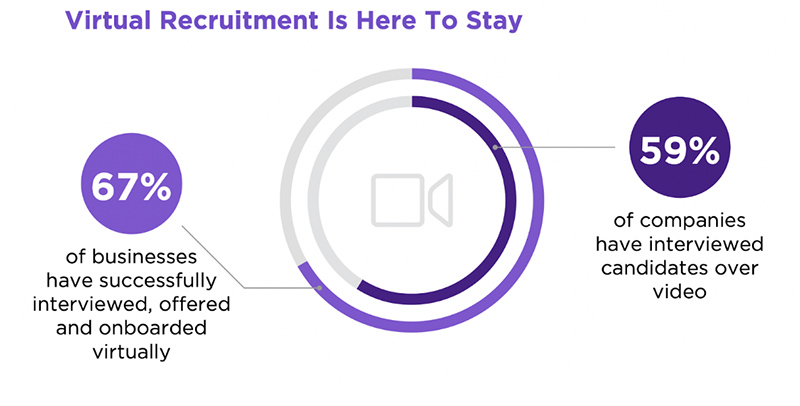By Grace Lau
As remote working continues to grow in popularity, so too grows the importance of curating an excellent digital employee experience. This experience needs to be in place right from the start of the recruitment process. Luckily, technology can come to the rescue.

HR departments have been able to use digital solutions for everything from record-keeping to L&D, and the recruitment process has felt the benefit of this too. Advertising jobs online, conducting interviews that don’t need physical spaces to be free, and many other parts of the recruitment process have been improved by this move.
One specific type of technological advance that has helped galvanise the digital potential of HR has been video conferencing. Even before the obvious factors that made remote work a reality for millions last year, this handy tool has made recruitment easier.
Video Conferencing: what is it, and what are the benefits?

So, let’s take a look at what video conferencing is. Simply put, video conferencing refers to the time when two or more people engage in an audio-visual internet call. This means that participants see and hear each other in a manner that standard phone calls don’t allow for.
As you can imagine, global businesses reap the benefits of this in obvious ways. For instance, if you’re a B2B ecommerce business with warehouses across the world, your HR team no longer needs to be based in the same place. Instead, video conferencing allows them to work from home, or, if you still want a physical office, one single location.
However, if you’re operating with staff all of whom are in the same country, or even city, it still has major advantages.
A move to hybrid working – that is working which mixes working from home with office work – has increased in popularity of late. Conversations around ways of working, process versus procedure, and the make up of a working week have accelerated, and making video conferencing a greater part of your overall operation helps with all of these areas.
Video conferencing allows for flexible working patterns, a move away from the office, and a reduction of rent and utility costs. But what are the best ways to leverage it for global recruitment, and what specific benefits does it offer you?
1. It’s better than phone calls
Phone calls are commonplace in recruitment – after all, you don’t want to invite every single person down to the office in person. Having short screening calls is, for many, standard practice. However, think about the opportunities you’re missing by being unable to see the person you’re speaking to.
It doesn’t matter whether you’re interviewing an architect or a sales manager, a software developer or a nurse, we’re all human, and communication has universal elements. With that being the case, seeing people that you’re screening, interviewing, or onboarding helps.
Most video conferencing software doesn’t only offer video, however. Many solutions offer screen-sharing, which is great for companies who might want to do a test. Imagine you’re hiring a developer, and want to watch them solve a problem. Video conferencing allows you to have a digital whiteboard space, where you can watch them work in real time.
2. Helps you find remote talent

As people become less bothered by geographical location and remote working becomes more popular, the boundaries to where you can hire from also become diluted. If your work isn’t so time-sensitive that you need people to be working at the same hours as everyone else, this can play to your advantage.
You can afford to search further afield for talent, and, as a result, do a better job of finding the “right person for the job”. Searching for executive talent in Europe or the Middle East when you’re an American business, for example, can globalise your enterprise brilliantly.
Video conferencing helps here too, meaning there’s no longer the need to fly people in for an interview. This ensures that you can interview people in the same manner, regardless of their proximity to you. It levels the playing field and broadens the scope you have to attract top-notch talent. And, in any HR professionals book, this has to be a win-win.
3. Increased interactivity
It might seem strange to suggest a video conference allows for more interactivity than an in-person one. But that’s exactly what we’re saying! Even when you’re in the same room as someone, interviews can be alarmingly disconnected. From being physically separated by desks and other furniture to potential disruptions from other colleagues, video conferencing eliminates this.
Now, we aren’t claiming that holding digital interviews allows you to be inherently more connected to the people you’re interviewing. But, there are definitely things it makes easier.

Having the screen set up for interviewees to play their video presentations, or by using the broadcasting tool that many of these programs allow for, reduces the awkwardness of everyone gathering around a laptop to look at a single screen.
Imagine, for example, that you’re looking for someone with experience in building mobile apps for business. Rather than them holding their phone up to walk you through an example, they can screen-share through your conferencing tool – showing off their work to the best of their ability.
Largely speaking, when you hire someone, they’re going to be working in an interactive digital environment, as part of a team or whatnot. So having this as part of your interview to see how they cope in this scenario can be of real help.
4. Easier onboarding
A lot of the points we’ve discussed until now have been about interviews, and with good reason. A large portion of the benefit afforded to you in recruitment by video conferencing is seen at the interviewing stage.
However, as we all know, this isn’t where HR’s job with new recruits ends. The onboarding process bridges the gap between the interviewing of a candidate and the point where someone begins to do the thing they’ve been hired for. And here too, video conferencing can help.
Quite apart from being more practical for overseas starters and for remote workers, onboarding is assisted here by the scale that video conferencing allows for. If you, for example, have 20 new recruits, getting them into a room for a couple of weeks of onboarding can be, especially in these times, something of a logistical nightmare.
Whether you’re a physical workspace like a call centre, or a digital one like a virtual law firm, video conferencing can make scheduling and enacting training much easier. All new recruits have to do is be on time to their computer in their own space. Not only will this make them feel more comfortable, but it allows you to minimise the resources that you have to supply for them.
5. Improves company culture
Not all onboarding has to be about the work, though. As people start in a new role, getting to know their colleagues and the culture of the organisation is equally if not more important than the content of their work. Some people will prefer to learn things as they do them for real. Yet practically everyone wants to make new connections almost immediately.

Failure to do so can lead people to believe that this role isn’t for them. And the candidates that you’ve screened, interviewed, and invested in could be out of the door before you even start. If you use conferencing to hold sessions that focus on the people as well as the work they’ll be doing, this gives you the chance to avoid this.
Consider arranging virtual ice-breakers, online ‘get to know you’ sessions, or team building games. Remote work can be lonely, especially when you’re only talking to people through email or text chat. Video conferencing allows you to put faces to names, and make a real human connection.
Plus, instigating a team spirit and a collective ethos from the jump can make people more willing to get on board with the more dry, boring areas of the onboarding process.
So what next?
If you haven’t already invested in a secure video conferencing solution, now is the time. It should be clear by now how it can be leveraged as part of a global recruitment process, and why this can be helpful to your company.
Speak to your HR team, and find out what they’d find helpful, what additional features they need, and how you can support them in digitising recruitment. By involving them in the process, you can ensure that whatever solution you choose will meet their needs and provide you with a top-notch recruitment experience.
About the Author

Grace Lau is the Director of Growth Content at Dialpad, an AI-powered cloud communication platform for better and easier team collaboration and one of the industry’s leading RingCentral alternatives. She has over 10 years of experience in content writing and strategy. Currently, she is responsible for leading branded and editorial content strategies, partnering with SEO and Ops teams to build and nurture content.


































